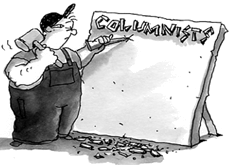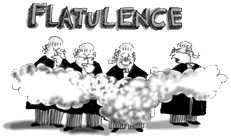What about my little mate?
 Critics' Corner •
Critics' Corner •  Friday, December 24, 2010
Friday, December 24, 2010 Andrew Clark reviews Pamela Burton's biography of Mary Gaudron, From Moree to Mabo ... As NSW Solicitor General, Gaudron's advice to the government about the Lionel Murphy affair was crucial ... The Age tapes ... A time when friendships and loyalty ran headlong into the law
 Of the four stanzas in Mary Gaudron's extraordinary legal career, it is the third, as NSW Solicitor General, that remains the most troubling.
Of the four stanzas in Mary Gaudron's extraordinary legal career, it is the third, as NSW Solicitor General, that remains the most troubling.
She is the poor child from the wrong side of the tracks who became a scholarship girl, brilliant law student, barrister, a deputy president of the Arbitration Commission, and High Court Judge - but she was never more tested than as second law officer of NSW.
"It was a role," Pamela Burton writes, "that would bring her into the public spotlight and leave her vulnerable to accusations of protecting her political bosses. Her principles, professionalism and objectivity would be tested."
This was the 80s, a time when changing social mores dramatically confronted Australia's oldest government with the sordid reality of decades of corruption - a system twisted by favours, paybacks, protection and venality.
Many trace its origins to early convict days and the Rum Rebellion. But it grew from the relative nickel-and-dime crime of C.J. Dennis' Sentimental Bloke and of SP bookmakers and two-up schools into one that penetrated the highest reaches of the police, courts, prisons, and, of course, the racetrack.
There was something rotten in the state of NSW, as the Bard might have written.
The issue of crime and corruption in NSW had been well aired before Mary Gaudron, the girl from Moree, became NSW Solicitor General in 1981.
However, its pervasive reach, including the courts, began unfolding like a Greek tragedy, and, this being NSW, it was often hard to decide, irrespective of official position, whose side key players were on.
Of course there also had to be a chorus - the press.
It was a world where, as Burton said:
"It has to be asked why people in public positions tend to be attracted to other powerful people without regard to whether they are of good character or repute. The racecourse, the hub of the 'network of influence,' seems to provide added magnetism. Mateships are formed, alcohol flows, things are said, gambling debts become leverage for favours, favours are traded and people in public positions are compromised."
There was, during her time as NSW Solicitor General, the scandal of Prisons Minister Rex (Buckets) Jackson, the "Love Boat" affair, the Kevin Humphreys registered clubs matter, the Bill Allen case, hounding of police whistleblower Philip Arantz, the Mr Asia drug syndicate and Nugan Hand.
Ultimately, and, for the legal profession, most troubling, there was Lionel Murphy.
All, one way or another, ended up on Mary Gaudron's desk, and often resulted in crucial delays.
It was also a time of legal ferment. The High Court, in a majority judgment, upheld the Commonwealth's power to stop the Franklin River dam, broadening the scope of the external affairs power to operate under the umbrella of international treaties.
Mary Gaudron displayed legal prescience when she wrote that "unless co-operative arrangements are made at intergovernmental level," the centralising tendency of judgments would continue.
She also had a healthy scepticism about the states' capacity to get their act together, given their inability "to agree even on the time of day".
But first things first. This is a very fine, at times brilliant, book.
It is born out of more than a decade of exhaustive, painstaking research, a questioning legal mind, and an author's background that complements the subject - a difficult, outspoken, coarse, driven, wayward, brilliant lawyer, one who reached the pinnacle of her profession, but never forgot from where she came. Mary Gaudron was many things, but she did not kow-tow, in manner or opinion, to a male legal establishment.
 John Burton & Doc EvattAn author's provenance may be regarded by black-letter literateurs as irrelevant, but in Pamela Burton's case it helps explain her facility with the subject.
John Burton & Doc EvattAn author's provenance may be regarded by black-letter literateurs as irrelevant, but in Pamela Burton's case it helps explain her facility with the subject.
She is the third daughter of John and Cecily Burton, the former being a onetime very young head of the Department of External Affairs, as it was then known, under Labor's Dr. H.V. Evatt as Foreign Minister.
As the Cold War mandated a binary "you're with us or against us" approach, Burton, by nature a promoter of mediation in international disputes, was forced out, and dogged by McCarthyist slurs.
This hounding had a contemporary echo when Burton's first daughter, Meredith, a distinguished, senior official in the Prime Minister's Department, was advised she had no future in the federal bureaucracy while John Howard remained as Prime Minister.
Mary Gaudron's background could not have been more different. She was the son of Ted, a railways worker in Moree, and life was hard. As Pamela Burton notes:
"The wealthier European townsfolk lived mainly in 'West Moree', north of the river; the railway community and an Aboriginal community were situated in East Moree, south of the Mehi River which runs through the middle of the town."
However, she was a bright, motivated, outspoken and cheeky girl. Mary Gaudron first developed the idea of going into the law when, by chance, and as an eight-year-old, she met Labor leader H.V. Evatt in 1951.
He was warning that Australia would become a police state if Robert Menzies succeeded in changing the Constitution allowing him to pass legislation outlawing the Communist Party.
After attending state school in Moree, and a Catholic girls' boarding school in Armidale, Gaudron won a Commonwealth scholarship, gained financial help from the Moree and Bullarooo Council, and supplemented her income with some night nursing, enabling her to study law at Sydney University.
The two key influences were Professor Julius Stone and Frank Hutley, who later became a judge of the NSW Court of Appeal.
According to Pamela Burton, Stone was recognised as "one of the leading legal theorists of the 20th century," but Hutley was more black letter and an academic foe of Stone. These two strands - the legal adventurer and the legal disciplinarian - emerged, in varying combinations, throughout her career.
In her final year, already married and working part-time, she won the university medal for law, the only woman to receive such recognition apart from Elizabeth Evatt.
Three years after graduating Gaudron was admitted to the bar.
From early on, she ran some memorable cases, including a defamation claim by Pat Mackie, leader of the drawn-out Mt Isa Mines strike in 1965. She also ran negligence cases, following the well worn path of Labor lawyers like Lionel Murphy, Jim Staples, Clive Evatt (Snr) and Frank Walker.
The Mackie case, a complicated "hand-me-down" from Clive Evatt, involved an article in the then Frank Packer-owned Daily Telegraph, and ended in a qualified victory for Gaudron and another "Labor" lawyer, Jim Staples.
The case attracted the attention of the newly-elected Whitlam Labor Government, and two years later, at the age of 31, she was appointed a Deputy President of the Conciliation and Arbitration Commission. Like Gaudron's stay at the bar, she was only at the commission for six years, and her resignation was bound up in the tortuous battle between Jim Staples, also a deputy president, and the commission president, Sir John Moore, and the Fraser Liberal Government. It was a period of torn loyalties.
While at the Arbitration Commission Gaudron again displayed prescience. She understood that a quasi judicial system with its roots in the pre-federation era of drawn out strikes, and a more equitable view of liberalism promoted by Alfred Deakin, was, in the more complex, modern world of the 70s, approaching its use-by date.
She called for the "establishment of proper avenues of communication between management and employes, which in turn tends to engender mutual understanding and respect".
There followed a six year stint - this time as Solicitor General for the NSW Labor Government, with Gaudron appointed to the post by her old university friend and Attorney General, Frank Walker. This proved to be a fascinating period, one where her intellectual and emotional powers were fully tested. The greatest test of all concerned her personal integrity.
Pamela Burton's strong Labor background does not prevent her from using her considerable intellectual rigour in addressing the troubling issues thrown up by the Murphy case, and others during Gaudron's period as NSW Solicitor General.  Murphy & Wran: what are friends for?She points to common links, including solicitor Morgan Ryan.
Murphy & Wran: what are friends for?She points to common links, including solicitor Morgan Ryan.
Murphy, a highly successful Sydney QC, leader of the Labor Party in the Senate, Attorney General in the Whitlam Government and High Court judge, and Ryan were friends; so, too, were Ryan and Labor Premier Neville Wran, and Ryan and sleazoid crime king Abe Saffron. At various times Wran and Murphy had worked with Ryan in the law.
Shortly before the March 1984 NSW election, Gaudron advised the Wran government that the so-called Age tapes, based on illegal police wiretaps which named both Wran and Murphy, contained unsafe and unreliable material on which to base charges.
It's important to emphasise that at this point none of the material naming Wran and Murphy implicated them in criminal activity.
Gaudron further advised the Wran government that any member of the police found to be involved in the illegal wiretapping should be disciplined – effectively, a disincentive to come forward with further information.
Little wonder then leader of the NSW Opposition, Nick Greiner, accused the Wran Government of "hiding behind the skirt of the Solicitor General" to avoid holding an inquiry into the substance of the tapes.
The cumulative effect of The Age tapes led to then Chief Stipendiary Magistrate Clarrie Briese claiming he had been leant on by Murphy.
Murphy is alleged to have said, "And now what about my little mate?" in relation to criminal charges against Morgan Ryan. Gaudron's scepticism about earlier Briese claims that he had been leant on by a District Court judge to influence the outcome of a charge against Ryan became public knowledge as two Senate inquiries were held into the Murphy matter.
The issues, according to Burton, came down to claims by the Opposition and some sections of the media that Gaudron's advice helped to protect her Labor "mates", including Murphy, against her belief in fair process.
Later, Gaudron conceded Briese's allegations and other claims swirling around at the time, should be referred to the Commonwealth Director of Public Prosecutions. In late November, 1984, the DPP, Ian Temby, recommended that Murphy face two charges of attempting to pervert the course of justice, both involving criminal proceedings against Morgan Ryan.
Murphy was convicted of one charge, but his appeal was successful, and he was acquitted in a re-trial.
The Labor government in Canberra established a special parliamentary commission of former judges to inquire into material relating to Murphy, but he died of cancer on October 21, 1986.
Gaudron was with Murphy when he was acquitted, and attended his special "live" wake at the Irish Embassy in Canberra. She was appointed to the High Court soon after.
Pamela Burton's book provides a remarkable personal insight into Mary Gaudron's contribution to the great legal decisions of the High Court during this period - Mabo, free speech, citizens' rights and others.
Mary Gaudron never forgot who she was. But to understand her at certain stages in her career, particularly as NSW solicitor general, is riddled with complications.
From Moree to Mabo - The Mary Gaudron Story, by Pamela Burton, University of Western Australia Press
Andrew Clark is a senior journalist with The Australian Financial Review
 Lionel Murphy,
Lionel Murphy,  Mary Gaudron,
Mary Gaudron,  Pamela Burton
Pamela Burton 









Reader Comments